2013 VOLKSWAGEN TOUAREG lock
[x] Cancel search: lockPage 290 of 440

Favorite destinations on the map
A favorite category can be specified for stored destinations Favorite destinations can be displayed on
the map with the orange favorite icon assigned to them (private �T or business �P
The list of favorite destinations is called up from the Destination entry menu .
Points of interest on the map
Points of interest can be selected as a navigation destination .
Points of interest are divided into point of interest categories. These point of interest categories are
assigned to blue point of interest icons (such as as �* hotel and �, petrol station).A list of
available point of interest categories can be called up from the Map settings menu. Map icons can
be selected there for display .
Display detailed information on points of interest
�x Press the symbol on the map briefly to display a window with further information.
Due to the map scale, there may be several entries behind one symbol on the map, in which case a
list appears for selecting an entry.
�x Select the required entry by pressing.
Function keys for further operation are displayed in the information window that appears.
�x Selecting points of interest and favorite destinations from the map .
�x TMC traffic reports on the map .
3D models on the map
An abstract 3D city model can be displayed in the �6 3D display type for some cities (such as Berlin).
In addition, special historical buildings and sights of interest are displayed as photo-realistic 3D
models.
To display these, autozoom needs to be switched off in some cases and you have to zoom further into
the map .
The display of 3D city models and 3D sights of interest is enabled and disabled in the map settings .
.If no symbols or 3D models can be displayed due to the scale, turn the setting knob clockwise
⇒ fig. 123 (3) in order to zoom in on the map.
Map settings: selecting map symbols
.�
Page 292 of 440
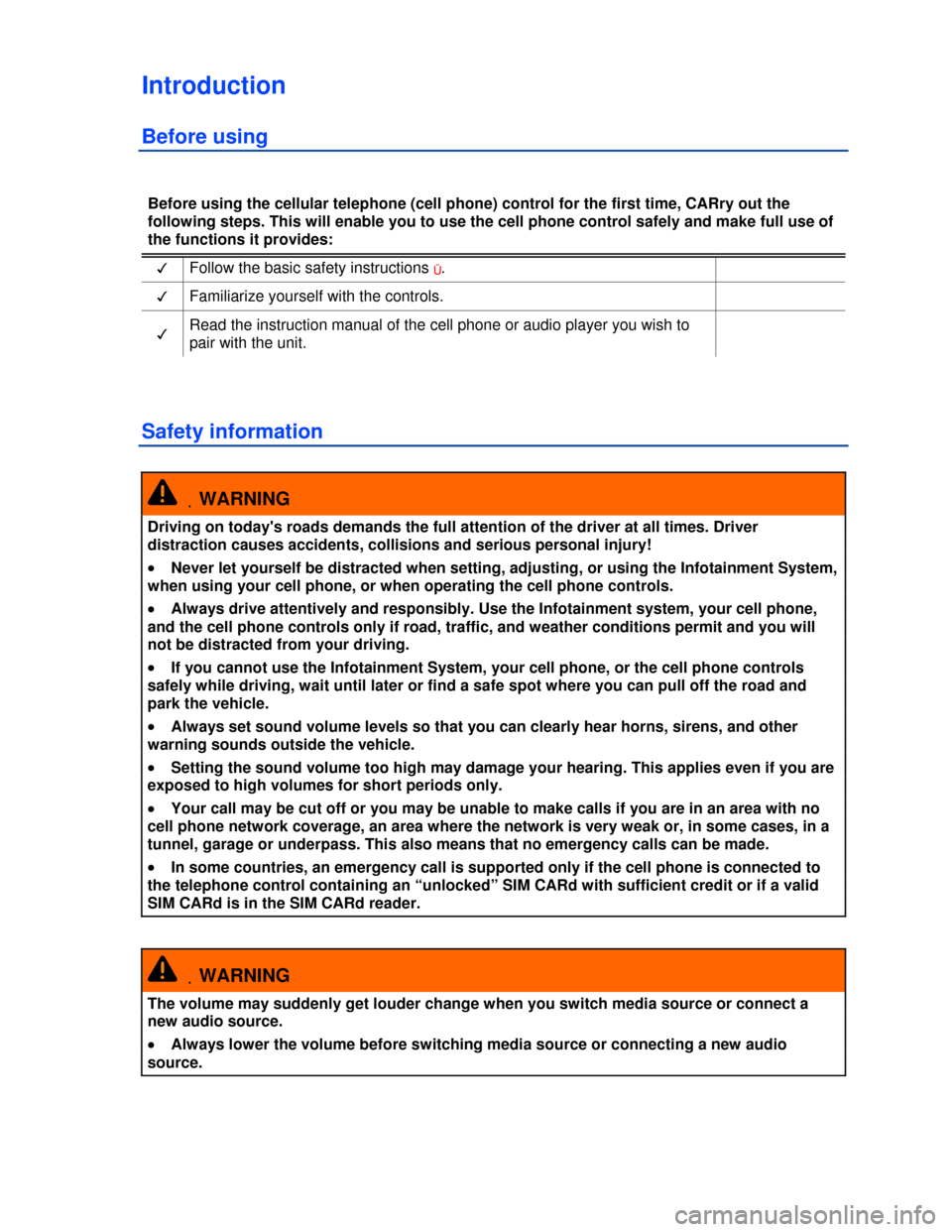
Introduction
Before using
Before using the cellular telephone (cell phone) control for the first time, CARry out the
following steps. This will enable you to use the cell phone control safely and make full use of
the functions it provides:
�d Follow the basic safety instructions Ü.
�d Familiarize yourself with the controls.
�d Read the instruction manual of the cell phone or audio player you wish to
pair with the unit.
Safety information
.WARNING
Driving on today's roads demands the full attention of the driver at all times. Driver
distraction causes accidents, collisions and serious personal injury!
�x Never let yourself be distracted when setting, adjusting, or using the Infotainment System,
when using your cell phone, or when operating the cell phone controls.
�x Always drive attentively and responsibly. Use the Infotainment system, your cell phone,
and the cell phone controls only if road, traffic, and weather conditions permit and you will
not be distracted from your driving.
�x If you cannot use the Infotainment System, your cell phone, or the cell phone controls
safely while driving, wait until later or find a safe spot where you can pull off the road and
park the vehicle.
�x Always set sound volume levels so that you can clearly hear horns, sirens, and other
warning sounds outside the vehicle.
�x Setting the sound volume too high may damage your hearing. This applies even if you are
exposed to high volumes for short periods only.
�x Your call may be cut off or you may be unable to make calls if you are in an area with no
cell phone network coverage, an area where the network is very weak or, in some cases, in a
tunnel, garage or underpass. This also means that no emergency calls can be made.
�x In some countries, an emergency call is supported only if the cell phone is connected to
the telephone control containing an “unlocked” SIM CARd with sufficient credit or if a valid
SIM CARd is in the SIM CARd reader.
.WARNING
The volume may suddenly get louder change when you switch media source or connect a
new audio source.
�x Always lower the volume before switching media source or connecting a new audio
source.
Page 326 of 440

On Hybrid vehicles depending on the environmental conditions and the current operating state
of the vehicle, either the combustion engine will be started or pure electric departure will be
enabled. This leaves the combustion engine off for the time being. In both cases, the vehicle
REA DY indicator will be displayed in the instrument cluster ⇒ table .
To stop the engine, again turn the vehicle key to the left or right and release. vehicle key can
then be removed from ignition switch.
To switch off the engine, turn the vehicle key either clockwise or counterclockwise and release.
The vehicle key can be removed from the ignition switch when the transmission shift lever is in
the (P) position.
If you use the wrong key
If an unauthorized remote control vehicle key has been inserted into the ignition switch, it can be
removed as follows:
�x The vehicle key cannot be removed from the ignition unless both the key and the selector lever
have been moved to the correct position. Press the release button on the transmission selector lever,
move the selector lever to the Park (P) position and release the button. The vehicle key can now be
removed.
.WARNING
Improper use of vehicle keys can result in serious personal injury.
�x Always take the key with you when you leave the vehicle. The engine can be started and
vehicle systems such as the power windows can be operated, leading to serious personal
injury.
�x Never leave children, disabled persons, or anyone who cannot help themselves in the
vehicle. The doors can be locked with the remote control vehicle key. This could result in
people being trapped in the vehicle in an emergency. For example, depending on the time of
year, people trapped in the vehicle can be exposed to very high or very low temperatures.
�x Heat build-up in the passenger and luggage compartment of a parked vehicle can result in
temperatures in the vehicle that are much higher than the outside temperatures, particularly
in summer. Temperatures can quickly reach levels that can cause unconsciousness and
death, particularly to small children.
�x Never remove the key from the ignition switch while the vehicle is moving or rolling to a
stop. The steering wheel will lock and you will not be able to steer or control the vehicle.
.Leaving the key in the ignition for a long time when the engine is not running will drain the
vehicle battery.
.Leaving the selector lever for a long period of time in any position other than Park (P) when the
ignition is switched off can drain the vehicle battery.
. The vehicle key can be removed from the ignition switch only when the transmission is in Park
.(P). You may have to press the release button on the transmission selector lever to put the lever into
Park (P).
Page 327 of 440
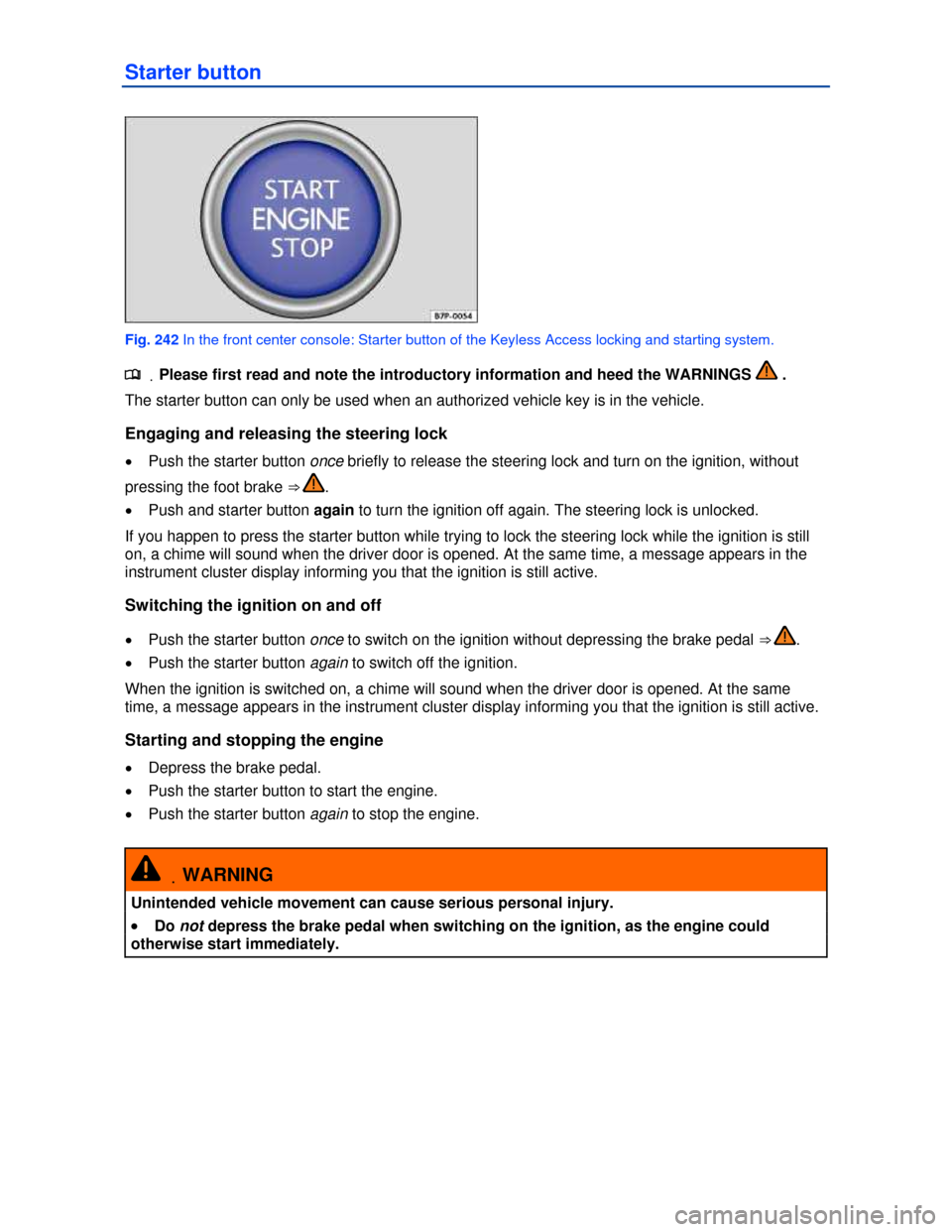
Starter button
Fig. 242 In the front center console: Starter button of the Keyless Access locking and starting system.
.�
Page 328 of 440
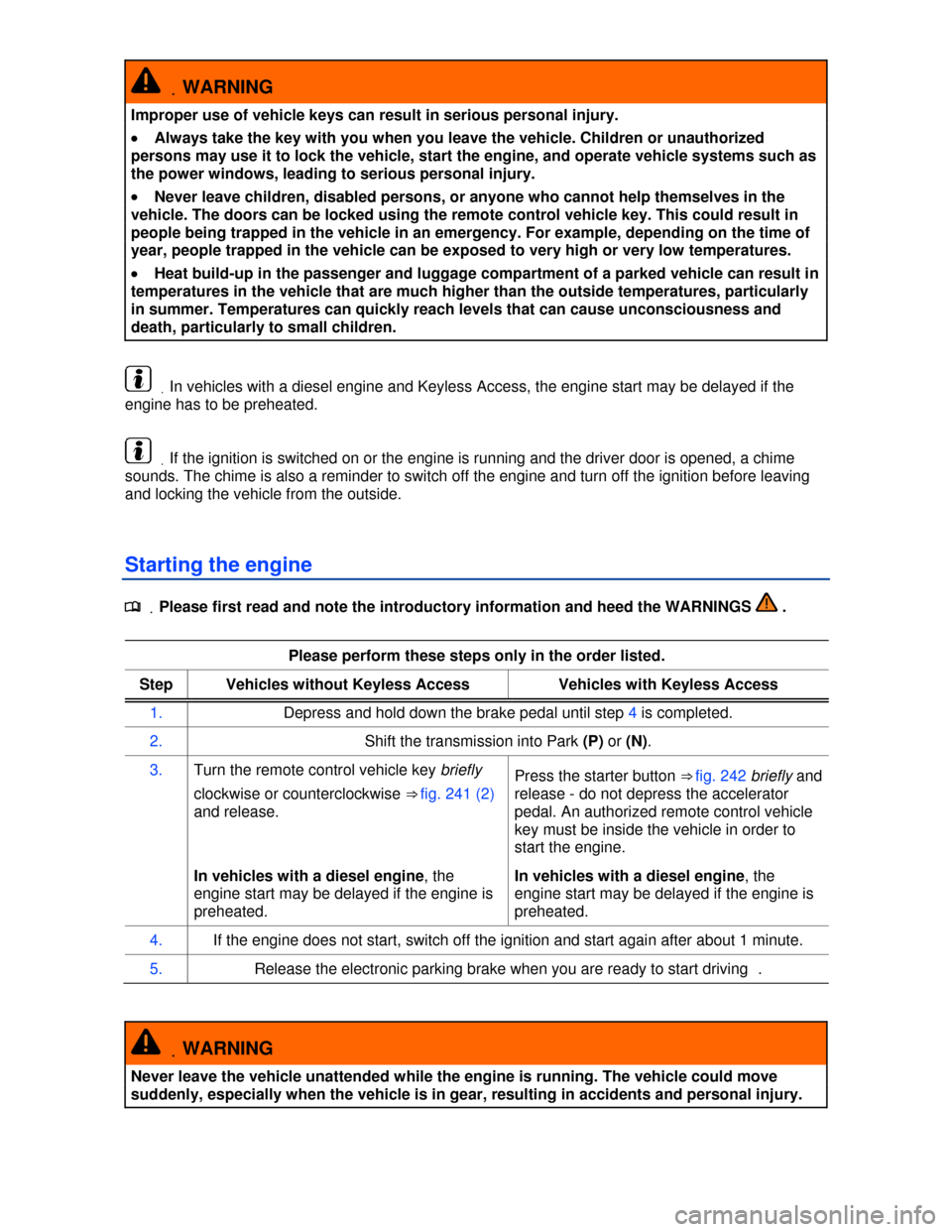
.WARNING
Improper use of vehicle keys can result in serious personal injury.
�x Always take the key with you when you leave the vehicle. Children or unauthorized
persons may use it to lock the vehicle, start the engine, and operate vehicle systems such as
the power windows, leading to serious personal injury.
�x Never leave children, disabled persons, or anyone who cannot help themselves in the
vehicle. The doors can be locked using the remote control vehicle key. This could result in
people being trapped in the vehicle in an emergency. For example, depending on the time of
year, people trapped in the vehicle can be exposed to very high or very low temperatures.
�x Heat build-up in the passenger and luggage compartment of a parked vehicle can result in
temperatures in the vehicle that are much higher than the outside temperatures, particularly
in summer. Temperatures can quickly reach levels that can cause unconsciousness and
death, particularly to small children.
.In vehicles with a diesel engine and Keyless Access, the engine start may be delayed if the
engine has to be preheated.
.If the ignition is switched on or the engine is running and the driver door is opened, a chime
sounds. The chime is also a reminder to switch off the engine and turn off the ignition before leaving
and locking the vehicle from the outside.
Starting the engine
.�
Page 329 of 440
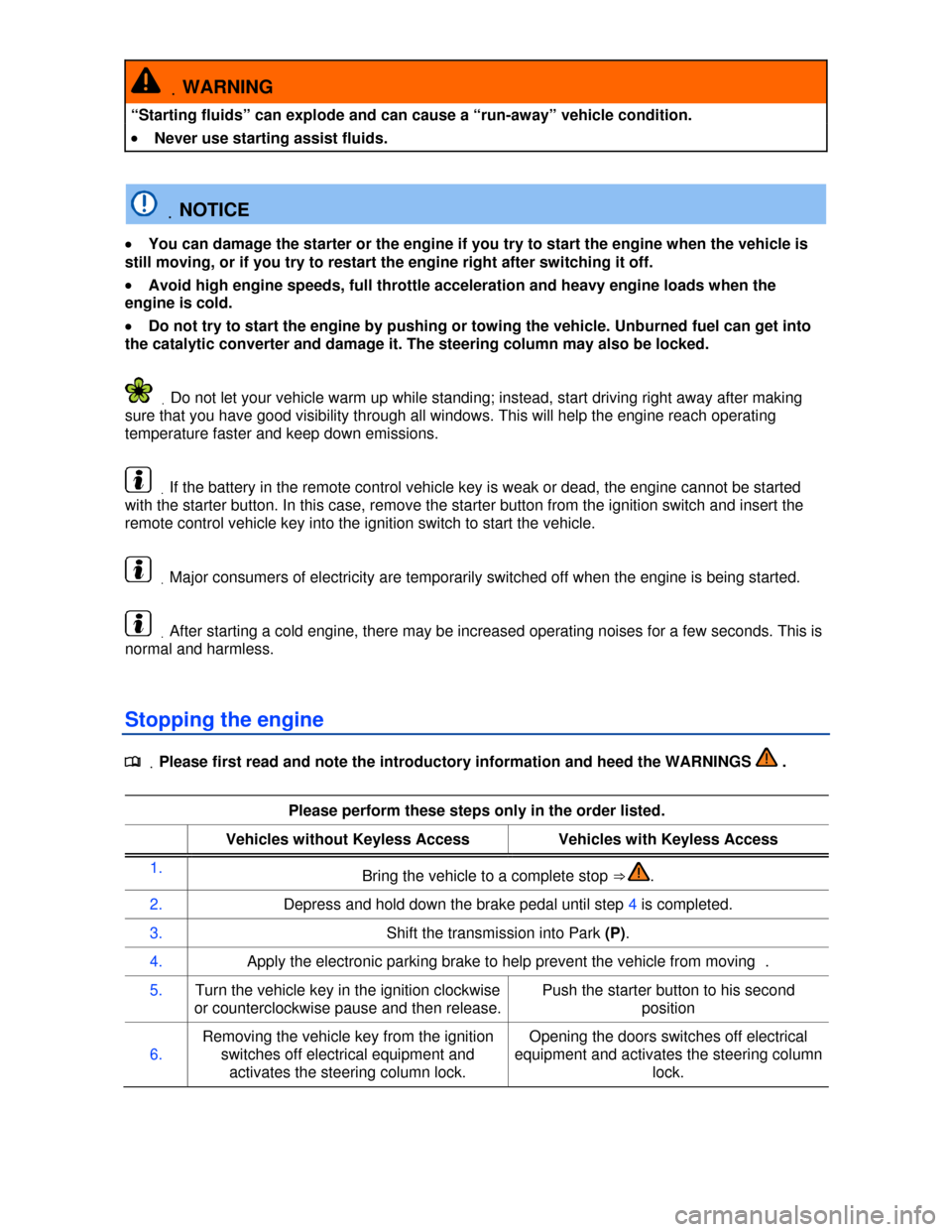
.WARNING
“Starting fluids” can explode and can cause a “run-away” vehicle condition.
�x Never use starting assist fluids.
.NOTICE
�x You can damage the starter or the engine if you try to start the engine when the vehicle is
still moving, or if you try to restart the engine right after switching it off.
�x Avoid high engine speeds, full throttle acceleration and heavy engine loads when the
engine is cold.
�x Do not try to start the engine by pushing or towing the vehicle. Unburned fuel can get into
the catalytic converter and damage it. The steering column may also be locked.
.Do not let your vehicle warm up while standing; instead, start driving right away after making
sure that you have good visibility through all windows. This will help the engine reach operating
temperature faster and keep down emissions.
.If the battery in the remote control vehicle key is weak or dead, the engine cannot be started
with the starter button. In this case, remove the starter button from the ignition switch and insert the
remote control vehicle key into the ignition switch to start the vehicle.
.Major consumers of electricity are temporarily switched off when the engine is being started.
.After starting a cold engine, there may be increased operating noises for a few seconds. This is
normal and harmless.
Stopping the engine
.�
Page 330 of 440
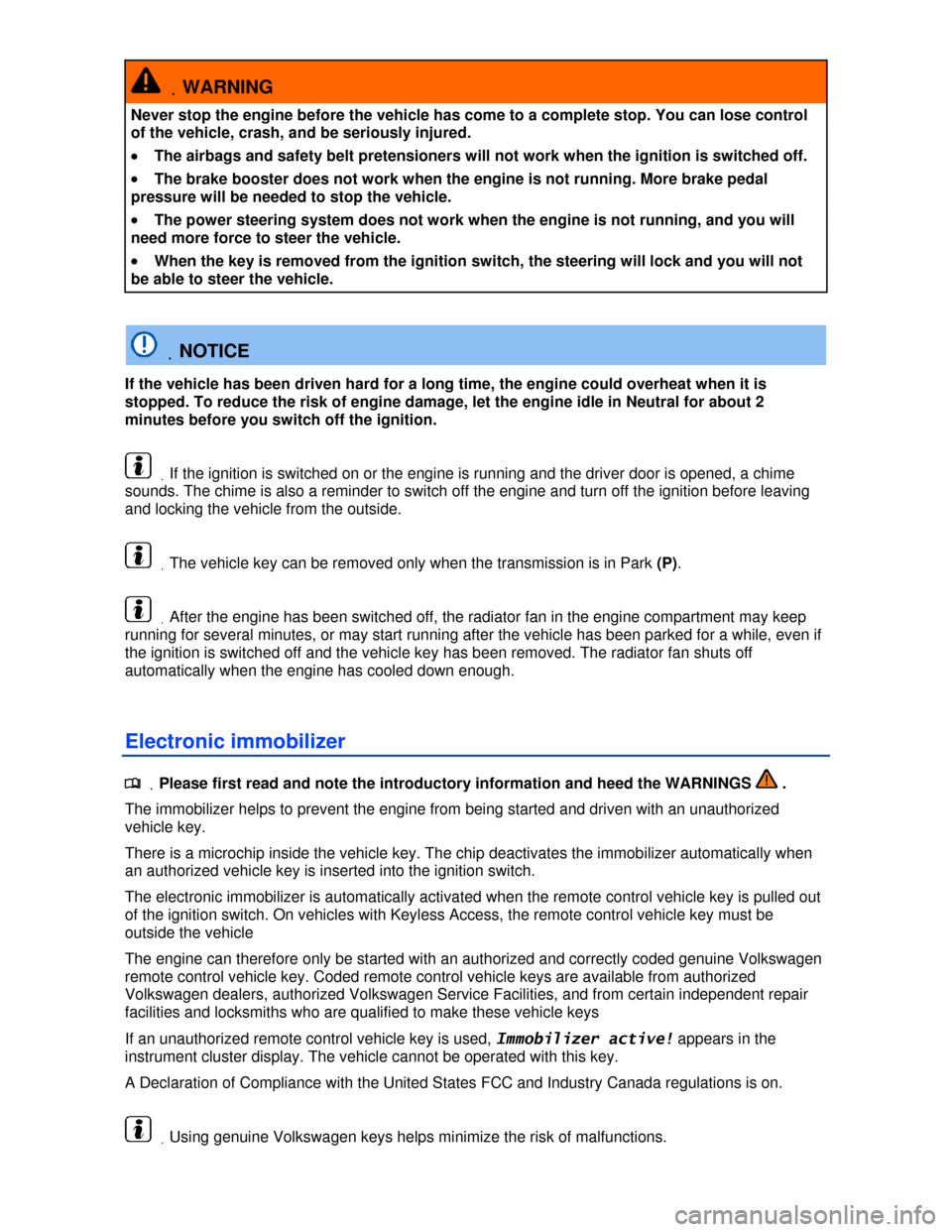
.WARNING
Never stop the engine before the vehicle has come to a complete stop. You can lose control
of the vehicle, crash, and be seriously injured.
�x The airbags and safety belt pretensioners will not work when the ignition is switched off.
�x The brake booster does not work when the engine is not running. More brake pedal
pressure will be needed to stop the vehicle.
�x The power steering system does not work when the engine is not running, and you will
need more force to steer the vehicle.
�x When the key is removed from the ignition switch, the steering will lock and you will not
be able to steer the vehicle.
.NOTICE
If the vehicle has been driven hard for a long time, the engine could overheat when it is
stopped. To reduce the risk of engine damage, let the engine idle in Neutral for about 2
minutes before you switch off the ignition.
.If the ignition is switched on or the engine is running and the driver door is opened, a chime
sounds. The chime is also a reminder to switch off the engine and turn off the ignition before leaving
and locking the vehicle from the outside.
.The vehicle key can be removed only when the transmission is in Park (P).
.After the engine has been switched off, the radiator fan in the engine compartment may keep
running for several minutes, or may start running after the vehicle has been parked for a while, even if
the ignition is switched off and the vehicle key has been removed. The radiator fan shuts off
automatically when the engine has cooled down enough.
Electronic immobilizer
.�
Page 335 of 440
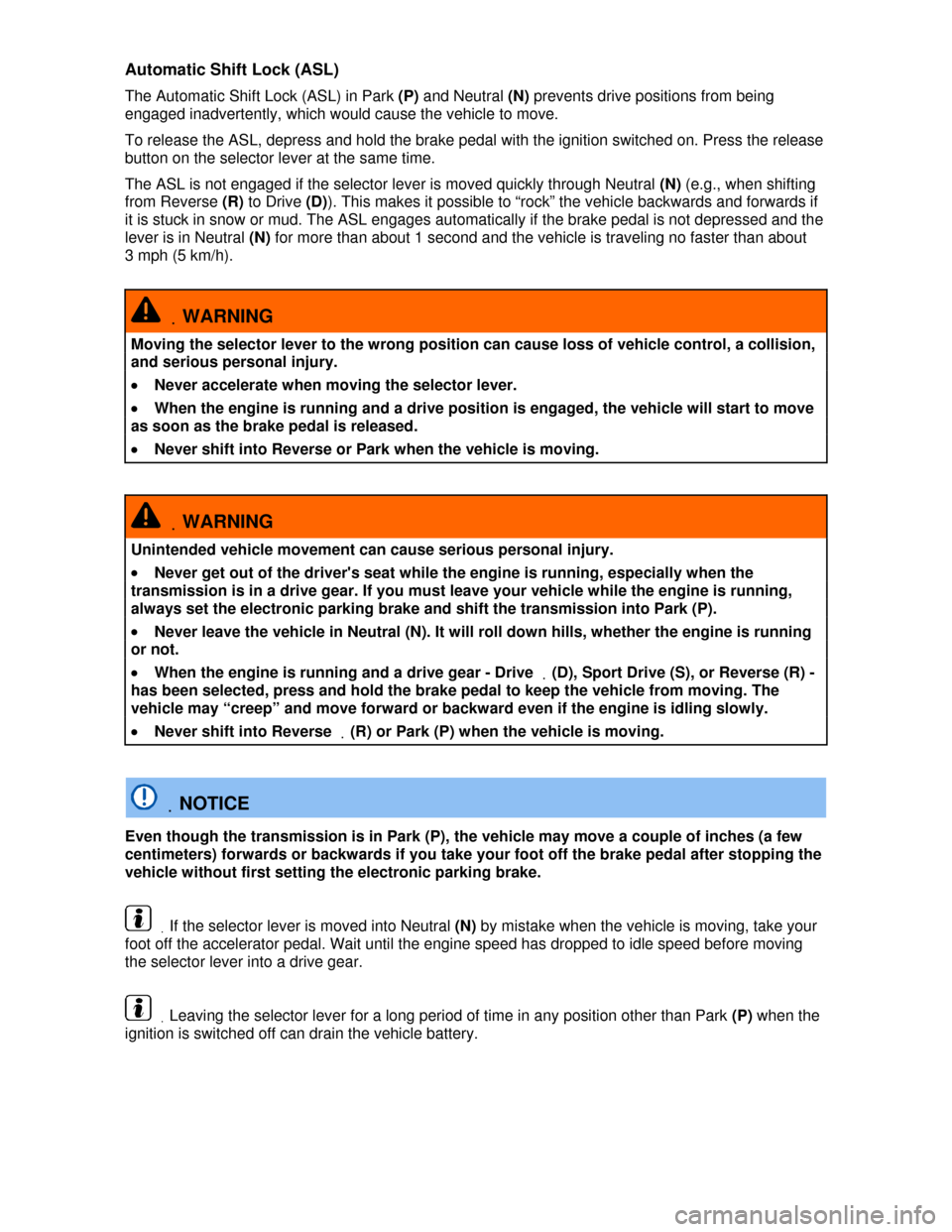
Automatic Shift Lock (ASL)
The Automatic Shift Lock (ASL) in Park (P) and Neutral (N) prevents drive positions from being
engaged inadvertently, which would cause the vehicle to move.
To release the ASL, depress and hold the brake pedal with the ignition switched on. Press the release
button on the selector lever at the same time.
The ASL is not engaged if the selector lever is moved quickly through Neutral (N) (e.g., when shifting
from Reverse (R) to Drive (D)). This makes it possible to “rock” the vehicle backwards and forwards if
it is stuck in snow or mud. The ASL engages automatically if the brake pedal is not depressed and the
lever is in Neutral (N) for more than about 1 second and the vehicle is traveling no faster than about
3 mph (5 km/h).
.WARNING
Moving the selector lever to the wrong position can cause loss of vehicle control, a collision,
and serious personal injury.
�x Never accelerate when moving the selector lever.
�x When the engine is running and a drive position is engaged, the vehicle will start to move
as soon as the brake pedal is released.
�x Never shift into Reverse or Park when the vehicle is moving.
.WARNING
Unintended vehicle movement can cause serious personal injury.
�x Never get out of the driver's seat while the engine is running, especially when the
transmission is in a drive gear. If you must leave your vehicle while the engine is running,
always set the electronic parking brake and shift the transmission into Park (P).
�x Never leave the vehicle in Neutral (N). It will roll down hills, whether the engine is running
or not.
�x When the engine is running and a drive gear - Drive .(D), Sport Drive (S), or Reverse (R) -
has been selected, press and hold the brake pedal to keep the vehicle from moving. The
vehicle may “creep” and move forward or backward even if the engine is idling slowly.
�x Never shift into Reverse .(R) or Park (P) when the vehicle is moving.
.NOTICE
Even though the transmission is in Park (P), the vehicle may move a couple of inches (a few
centimeters) forwards or backwards if you take your foot off the brake pedal after stopping the
vehicle without first setting the electronic parking brake.
.If the selector lever is moved into Neutral (N) by mistake when the vehicle is moving, take your
foot off the accelerator pedal. Wait until the engine speed has dropped to idle speed before moving
the selector lever into a drive gear.
.Leaving the selector lever for a long period of time in any position other than Park (P) when the
ignition is switched off can drain the vehicle battery.